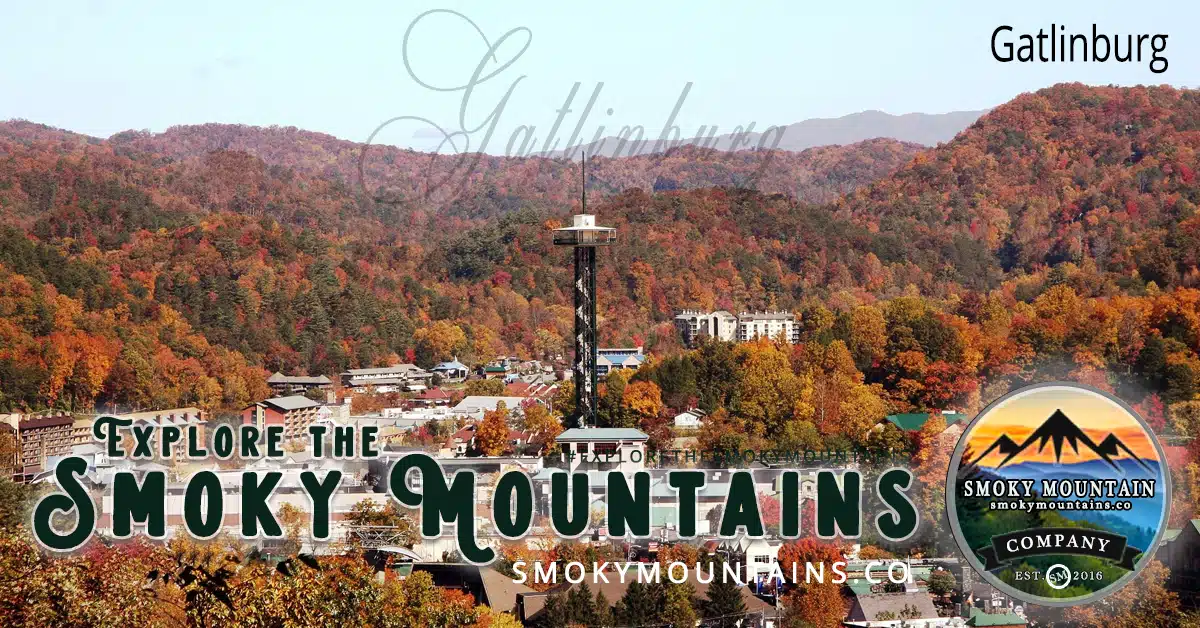The Great Smoky Mountains National Park is located in the eastern United States, straddling the border between Tennessee and North Carolina. It is one of the largest protected areas in the east of the United States and the country’s most visited national park.
The park is known for its stunning scenery, with over 520,000 acres of rolling hills, forests, and diverse wildlife. Visitors can enjoy hiking, camping, fishing, and wildlife viewing in the park and scenic drives along the many roads that wind through the mountains.
One of the main attractions in the park is the scenic drive along Newfound Gap Road, which crosses over the spine of the Great Smoky Mountains and offers breathtaking views of the surrounding peaks and valleys. Other popular attractions include Clingmans Dome, the highest point in the park, which offers panoramic views of the surrounding mountains and Cades Cove. This beautiful valley is home to many historic buildings and abundant wildlife.
The Great Smoky Mountains National Park is also home to a rich diversity of plant and animal life, with over 1,500 species of flowering plants and a wide range of wildlife, including black bears, white-tailed deer, wild turkeys, and a variety of birds.
Overall, the Great Smoky Mountains National Park is a must-visit destination for those looking to experience the beauty and diversity of the natural world. Whether you’re a hiker, camper, wildlife enthusiast, or simply looking to take in stunning views, the park offers something for everyone.
Clingmans Dome
Clingmans Dome is a peak in the Great Smoky Mountains National Park in Tennessee, USA. It is the highest point in the park, standing at an elevation of 6,643 feet (2,025 meters) above sea level.
Clingmans Dome is one of the most popular destinations in the park, attracting visitors from all over the world to its stunning panoramic views of the surrounding mountains. The peak can be reached via a paved trail that leads to an observation tower at the summit, offering 360-degree views of the surrounding peaks and valleys.
In addition to its scenic beauty, Clingmans Dome is also a popular destination for hiking and wildlife viewing. The area around the dome is home to a wide range of plant and animal life, including rare species of spruce-fir forest and various bird species, such as the colorful Northern Oriole and the distinctive Blackburnian Warbler.
Clingmans Dome is also a popular spot for stargazing due to its high elevation and relative distance from city lights, making it one of the best places in the park for observing the night sky.
Overall, Clingmans Dome is a must-visit destination for those looking to experience the breathtaking views and unique natural environment of the Great Smoky Mountains National Park. Whether you’re a hiker, nature lover, or simply looking to take in the stunning scenery, Clingmans Dome offers a one-of-a-kind experience in the heart of the mountains.
Cades Cove
Cades Cove is a valley in the Great Smoky Mountains National Park in Tennessee, USA. It is one of the most popular destinations in the park, attracting visitors from all over the world to its stunning scenery, rich history, and abundant wildlife.
Cades Cove is surrounded by lush forests and rolling hills, with a quiet 11-mile loop road that provides scenic views of the valley and its historic buildings. Along the route, visitors can stop at several historic sites, including log cabins, barns, and a gristmill, which offer a glimpse into the area’s past and the lives of the settlers who once lived there.
In addition to its historical significance, Cades Cove is also home to abundant wildlife, including white-tailed deer, black bears, and wild turkeys. Wildlife watching is popular in the valley, and visitors can often see animals grazing in the fields or wandering through the forest.
Cades Cove is also a popular destination for hiking and picnicking, with several trails leading into the surrounding forest and a picnic area near the start of the loop road. The valley is also a popular spot for photographers, with its picturesque scenery providing a backdrop for stunning photos of the surrounding landscape.
Cades Cove is a must-visit destination for those looking to experience the unique history, wildlife, and scenic beauty of the Great Smoky Mountains National Park. Whether you’re a history buff, nature lover, or simply looking to enjoy a peaceful afternoon in the mountains, Cades Cove has something to offer everyone.
Hiking Spots
The Great Smoky Mountains National Park is one of the most popular hiking destinations in the United States, offering a wide range of trails for hikers of all skill levels. Here are some of the top hiking spots in the park:
- Clingmans Dome: This is the highest point in the park and offers stunning views from the observation tower.
- Andrews Bald: A 3-mile round trip hike to an open, grassy bald offering panoramic views.
- Charlies Bunion: A strenuous 8-mile round trip hike to a rock outcropping with breathtaking views.
- Alum Cave Trail: A 5-mile round trip hike to a unique bluff shelter with scenic views along the way.
- Grotto Falls: A 2.6-mile round-trip hike to a waterfall that you can walk behind.
- Rainbow Falls: A 5.4-mile round-trip hike to an 80-foot waterfall.
- Mount LeConte: A strenuous hike to the third-highest peak in the park, offering panoramic views from the summit.
- Laurel Falls: A 2.6-mile round-trip hike to an 80-foot waterfall.
These are just a few of the many hiking options available in the Great Smoky Mountains National Park. It’s always a good idea to check the park’s official website for trail conditions and updates before setting out on a hike.
The History of The Great Smoky Mountains National Park
The Great Smoky Mountains National Park is a protected area in the Appalachian Mountains of Tennessee and North Carolina. The park was established on June 15, 1934, and covers over 500,000 acres of land.
The history of the Great Smoky Mountains dates back to the prehistoric era when various Native American tribes inhabited the area. European settlers arrived in the region in the late 1700s and early 1800s and established homesteads and farms in the valley.
In the late 19th and early 20th centuries, concerns over the rapid deforestation and commercialization of the mountains led to the formation of the Great Smoky Mountains Conservation Association. The group’s efforts and support from the national government eventually led to the creation of the Great Smoky Mountains National Park.
During the Great Depression, the Civilian Conservation Corps (CCC) was instrumental in developing the park’s infrastructure and building trails, campgrounds, and other facilities. The CCC also worked to reforest areas that had been cleared for agriculture and logging.
Today, the Great Smoky Mountains National Park is one of the most visited national parks in the United States, attracting millions of visitors each year. The park is known for its diverse ecosystems, including lush forests, streams, and waterfalls, as well as its rich cultural and historical heritage. The park is also home to a wide variety of wildlife, including black bears, elk, and over 1,500 species of plants.
Interesting facts about the Great Smoky Mountains National Park:
- The Great Smoky Mountains are one of the oldest mountain ranges in the world and are estimated to be over 200 million years old.
- The park is home to the largest concentration of black bears in the eastern United States, with an estimated population of over 1,500 bears.
- The Great Smoky Mountains are also known for their diverse plant life, with over 1,500 species of flowering plants and over 100 species of trees.
- The park is home to several historic communities, including the town of Cades Cove, which was settled in the early 19th century and is now a popular tourist destination.
- The park is also home to several historic structures, including log cabins, grist mills, and barns, many of which have been restored and are open to the public.
- The Great Smoky Mountains National Park is also known for its rich cultural heritage, with some historic sites and museums dedicated to the park’s history and the people who lived in the region.
- The park is also home to several hiking trails, including the Appalachian Trail, which stretches over 2,000 miles from Georgia to Maine.
- The Great Smoky Mountains National Park is also a popular destination for wildlife viewing, with a wide variety of animals, including black bears, elk, deer, and over 200 species of birds.
- The park is also known for its beautiful scenic drives, including the Newfound Gap Road, which offers stunning views of the mountains and the surrounding countryside.
- The Great Smoky Mountains National Park is also well-known for outdoor recreational activities, including camping, fishing, and horseback riding.
The Great Smoky Mountains National Park is one of the most visited national parks in the United States, attracting millions of visitors each year. According to the National Park Service, the park received over 12.5 million visitors in 2020, making it the most visited national park in the country.
Visitation to the park has been steadily increasing over the years, and the park typically receives the most significant number of visitors during the summer months. However, the COVID-19 pandemic has impacted visitor numbers, with a decrease in visitors in 2020 compared to previous years.
Despite the decrease in visitors, the Great Smoky Mountains National Park remains a popular destination for outdoor enthusiasts, nature lovers, and families, who come to explore the park’s diverse ecosystems, rich cultural heritage, and breathtaking scenery.
Things to do in The Great Smoky Mountains National Park
The Great Smoky Mountains National Park offers a wide range of activities for visitors of all ages and interests. Here are some popular things to do in the park:
- Hiking: The park has over 800 miles of trails, ranging from easy walks to challenging backcountry hikes.
- Wildlife viewing: The park is home to a diverse array of wildlife, including black bears, elk, deer, and over 200 species of birds.
- Scenic drives: The park offers several scenic drives, including the Newfound Gap Road, which offers stunning views of the mountains and the surrounding countryside.
- Camping: The park has ten developed campgrounds, as well as backcountry camping opportunities for those who want to explore the park’s wilderness areas.
- Fishing: The park is home to over 2,000 miles of streams, many of which are stocked with trout.
- Horseback riding: The park has several stables that offer horseback riding opportunities, allowing visitors to explore the park’s scenic trails on horseback.
- Historic sites: The park is home to several historic sites, including the town of Cades Cove, which was settled in the early 19th century and is now a popular tourist destination.
- Museums and interpretive centers: The park is also home to several museums and interpretive centers, which provide visitors with information about the park’s history, culture, and natural resources.
- Picnicking: The park has several picnic areas, offering visitors the opportunity to enjoy a scenic lunch or dinner surrounded by the beauty of the park.
- Winter sports: During the winter months, the park offers opportunities for cross-country skiing, snowshoeing, and sledding.
Seasons in Smoky Mountains National Park
Fall in the Great Smoky Mountains National Park
Fall is a popular time to visit the Great Smoky Mountains National Park. During this season, the park is known for its stunning fall foliage, with the deciduous trees displaying reds, yellows, and oranges. The fall foliage typically peaks in late October and early November, but the exact timing can vary yearly, depending on the weather conditions.
Some popular activities during the fall season in the park include:
- Hiking: The park’s trails offer some of the best views of the fall foliage, and there are many trails to choose from, ranging from easy walks to challenging backcountry hikes.
- Scenic drives: The park’s scenic drives, such as the Newfound Gap Road and the Roaring Fork Motor Nature Trail, offer stunning views of the fall colors and are popular with visitors.
- Wildlife viewing: The fall is a great time to see wildlife in the park, as bears and other animals are actively foraging in preparation for winter.
- Photography: With its breathtaking fall colors and scenic views, the park is a photographer’s paradise during the fall season.
- Festivals: The park and surrounding communities host several fall festivals, including the Fall Heritage Festival in Cades Cove and the Smoky Mountain Harvest Festival in Gatlinburg.
- Camping: The park’s campgrounds are open year-round, and fall is a great time to enjoy the cool weather and colorful scenery.
Whether you’re interested in hiking, wildlife viewing, or simply enjoying the park’s scenic beauty, fall is a great time to visit the Great Smoky Mountains National Park.
Winter in the Great Smoky Mountains National Park
Winter is quieter in the Great Smoky Mountains National Park, but it is still a beautiful season to visit. During the winter, the park is blanketed in snow, offering a peaceful and serene landscape for visitors to enjoy.
Here are some popular winter activities in the park:
- Winter hiking: Some of the park’s trails are open for winter hiking, offering visitors the chance to experience the park’s beauty in a different season.
- Cross-country skiing: The park has several trails suitable for cross-country skiing, providing a unique way to explore the park’s winter landscape.
- Snowshoeing: Snowshoeing is a popular activity in the park during the winter, and the park has several trails that are suitable for this activity.
- Sledding: The park has several sledding hills open to visitors, providing a fun and thrilling winter activity for families and children.
- Wildlife viewing: Winter is a great time to see wildlife in the park, as the snow makes it easier to spot tracks and signs of animals.
- Winter camping: The park’s campgrounds are open year-round, and winter camping offers visitors the chance to enjoy the park’s quiet and peaceful winter landscape.
- Photography: With its snow-covered landscapes and serene scenery, winter is a great time to photograph in the park.
Whether you’re interested in winter sports, wildlife viewing, or simply taking in the park’s scenic beauty, the Great Smoky Mountains National Park has something to offer during the winter. Just be sure to check with the park for any winter weather warnings or trail closures, as conditions can be unpredictable during this time of year.
Summer in the Great Smoky Mountains National Park
Summer is a popular time to visit the Great Smoky Mountains National Park. During the summer, the park’s weather is warm and sunny, making it ideal for various outdoor activities.
Here are some popular summer activities in the park:
- Hiking: The park has over 800 trails, ranging from easy walks to challenging backcountry hikes. Summer is a great time to explore the park’s scenic trails and enjoy the warm weather.
- Wildlife viewing: Summer is a great time to see wildlife in the park, as many animals are active and visible during this time of year.
- Scenic drives: The park offers several scenic drives, including the Newfound Gap Road and the Roaring Fork Motor Nature Trail, which offer stunning views of the mountains and the surrounding countryside.
- Camping: The park has ten developed campgrounds and backcountry camping opportunities for those who want to explore the park’s wilderness areas.
- Fishing: The park is home to over 2,000 miles of streams, many of which are stocked with trout, making it a popular destination for fishing enthusiasts.
- Horseback riding: The park has several stables that offer horseback riding opportunities, allowing visitors to explore the park’s scenic trails on horseback.
- Historic sites: The park is home to several historic sites, including the town of Cades Cove, which was settled in the early 19th century and is now a popular tourist destination.
- Museums and interpretive centers: The park is also home to several museums and interpretive centers, which provide visitors with information about the park’s history, culture, and natural resources.
- Picnicking: The park has several picnic areas, offering visitors the opportunity to enjoy a scenic lunch or dinner surrounded by the park’s beauty.
Whether you’re interested in exploring the park’s natural beauty, learning about its rich cultural heritage, or simply enjoying some time in the great outdoors, there is something for everyone in the Great Smoky Mountains National Park during the summer months.
Spring in The Great Smoky Mountains National Park
Spring is a beautiful time to visit the Great Smoky Mountains National Park. The park comes to life during the spring as the weather warms up and the trees and wildflowers bloom.
Here are some popular spring activities in the park:
- Hiking: The park has over 800 miles of trails, ranging from easy walks to challenging backcountry hikes. Spring is a great time to explore the park’s scenic trails and enjoy the warm weather.
- Wildflowers: The park is known for its diverse plant life, and spring is a great time to see its wildflowers bloom.
- Waterfalls: The park is home to many waterfalls, and spring is a great time to visit them as the water flow is typically at its highest.
- Scenic drives: The park offers several scenic drives, including the Newfound Gap Road and the Roaring Fork Motor Nature Trail, which offer stunning views of the mountains and the surrounding countryside.
- Wildlife viewing: Spring is a great time to see wildlife in the park, as many animals are active and visible during this time of year.
- Historic sites: The park is home to several historic sites, including the town of Cades Cove, which was settled in the early 19th century and is now a popular tourist destination.
- Museums and interpretive centers: The park is also home to several museums and interpretive centers, which provide visitors with information about the park’s history, culture, and natural resources.
- Picnicking: The park has several picnic areas, allowing visitors to enjoy a scenic lunch or dinner surrounded by the park’s beauty.
Whether you’re interested in exploring the park’s natural beauty, learning about its rich cultural heritage, or simply enjoying some time in the great outdoors, there is something for everyone in the Great Smoky Mountains National Park during the spring season.




